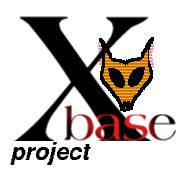For version 3 memo field files, there are two fields in the head block of the file, NextBlockNo and Version. Depending on the Xbase software, some vendors products update these two fields, some do not. The Xbase library keeps the fields updated, but does not rely on them to be valued with correct data. This helps to support maximum compatibility amoungst all Xbase tools available.
For version 4 memo field files, the first block in the .DBT file is a header block which is comprised of 8 bytes of data which maintain the file's block size and the next free block available in the file. Blocks two through n contain the actual memo data. A chain of empty blocks is maintained within the file for potential future use. When an add or update routine executes, it first attempts to find a spot in a set of blocks which were earlier allocated, but not currently in use for the data. If no free spot is found, data are appended to the end of the file. The free block chain is sorted in block number order. When blocks of data are freed and added to the free block chain, the routines will attempt to concatonate free block chains togethor where possible. When a delete occurs, or an update which requires less space occurs, the new free space is added to the free block chain.
Various Memo File Block Types
| Valid Block Types |
|---|
| Head Block |
| Only data block for memo field |
| First of several contiguous data block set |
| 2-n of contiguous data block set |
| Only data block in free chain (version IV only) |
| First of several contiguous free block set (version IV only) |
| 2-n of contiguous free block set (type 4 only) |
Head Block Structure
| 1-4 | LONG | Next Block ID |
|---|---|---|
| 5-8 | LONG | Not used all 0x00's |
| 9-16 | CHAR(8) | Filename (Version IV Only) |
| 17 | CHAR | Version (0x03 = Version III, 0x00 = Version IV) |
| 18-20 | CHAR(3) | Not used all 0x00's |
| 21-22 | SHORT | Block Size (Version IV only ) |
| 23-Remainder of block | CHAR | Not used |
Version IV Head Data Block Structure
| xbShort | 0-1 | -1 |
|---|---|---|
| xbShort | 2-3 | Starting position of data (always 8 ?) |
| xbLong | 4-7 | Length of data includes first 8 bytes |
| char (9) - Blocksize | 8-15 | Data |
Version IV Head Free Block Structure
| xbLong | 0-3 | Next free block in the free block chain |
|---|---|---|
| xbLong | 4-7 | Number of free blocks in this contiguous free block set |
Version 3 and 4 memo fields are terminated with two contiguous 0x1A bytes of data.
64 Bit File Support
Beginning with Release 3.0 of the library, Xbase was renamed to Xbase64 and 64 bit file support was incorporated into the library.This functionality currently works on Linux/Unix platforms which support 64 bit file structures. 64 bit support was not tested with Windows because the author didn't have access to a compiler which creates 64 bit Windows apps. If you need this functionality for Windows, consider donating a Windows 64 bit compiler to the project and I'll get 64 bit support working for Windows.
It is not advisable to use Xbase 64 bit file support in combination with 32 bit Xbase applications such as older versions of DBase, Clipper and Foxpro. Xbase64 can extend the files well beyond any limits in the older 32 bit application development environments.
If Xbase is being built with glibc, verify it is at least version 2.2.3.
